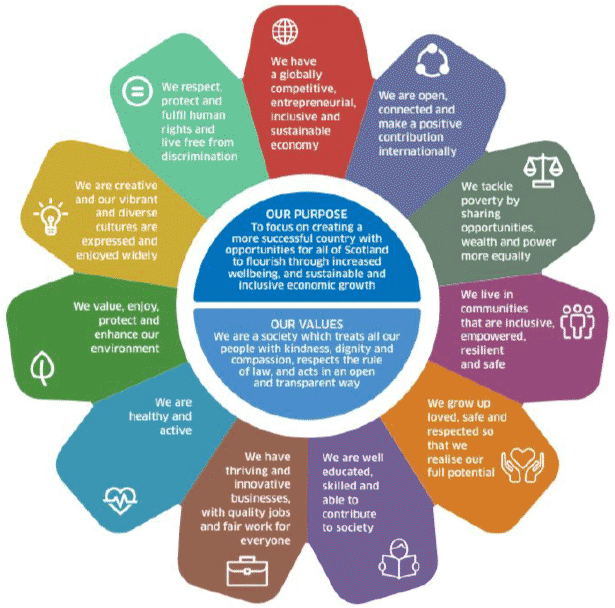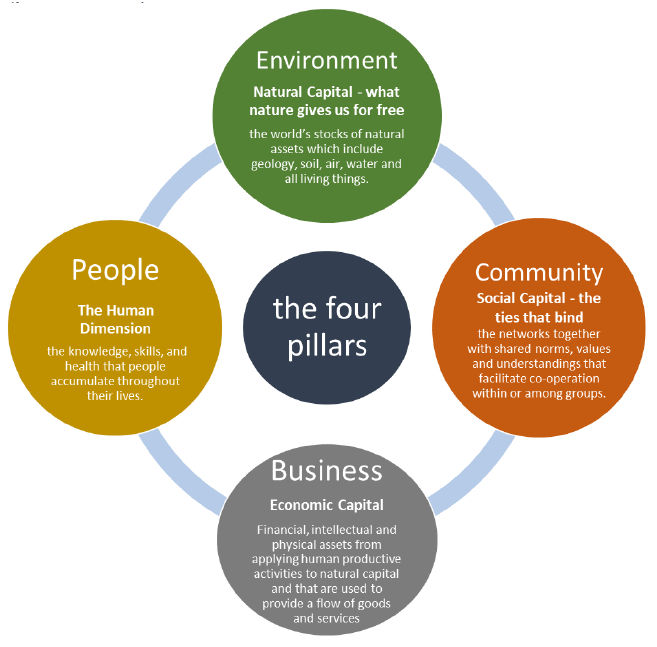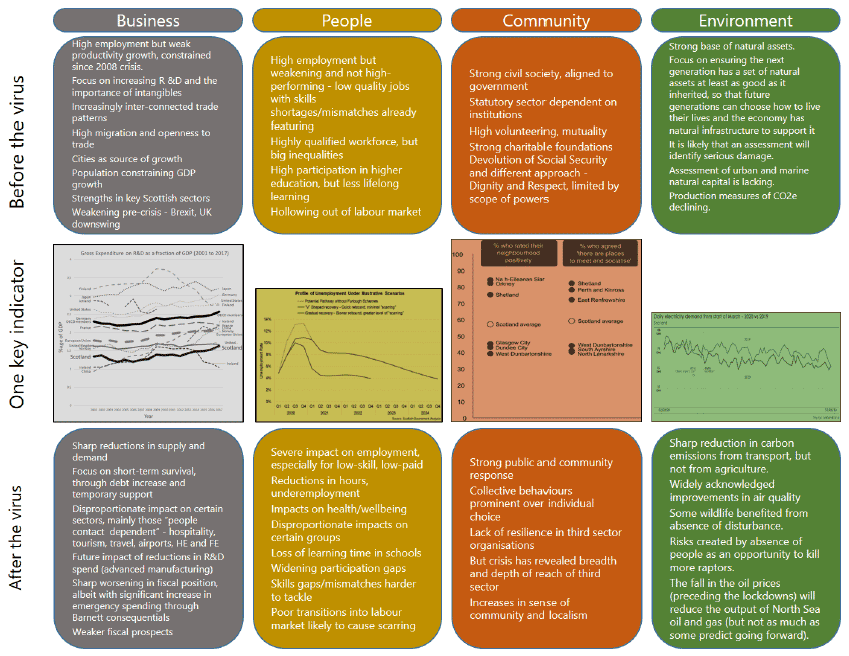Towards a Robust, Resilient Wellbeing Economy for Scotland: Report of the Advisory Group on Economic Recovery
Report from the independent Advisory Group established by the Scottish Government to advise on Scotland’s economic recovery in the wake of the COVID-19 pandemic.
3. The National Performance Framework and the Four Capitals
The Scottish Government's National Performance Framework (NPF)[10] provides an overarching view of how Scotland is faring; and is a critical and broadly accepted barometer of success. It is a sound framework which is still just as relevant after the crisis; and the Group has taken this as the key policy backdrop for our discussions.

Figure 6 description
This figure shows the national performance framework "petal" or "cog" which illustrates the 11 National outcomes arranged around a central circle containing the governments purpose and values. Full details are available at nationalperformance.gov.scot
But we wanted to adopt a broad and robust framework for looking at the Scottish economy that would capture all of its assets and provide the basis for a holistic view of paths to a more robust and resilient economy in the future. In that context, we have found the 'Four Capitals' approach a helpful tool for analysis.

Figure 7 description
This figure shows the 4 capitals - Business, Community, Environment and People with short descriptive text that is expanded upon in the main text of the report.
3.1 The Four Capitals
For business, economic capital (as we use the term) includes physical, intellectual and financial assets. The traditional notion of (physical) capital is the outcome of applying human capital to natural capital to generate physical assets that provide a flow of goods or services, with the classic example being the machinery in a factory but also including wider aspects of public (or private) infrastructure (roads, bridges, power stations). Whilst some notions of intellectual capital are closely related to human capital, a reasonable view is to consider the 'intangible assets' of organisations (goodwill, brand recognition and intellectual property) that are wider than a single person, whilst accepting that this also has links to social capital in some respects. Finally, financial capital consists of the financial resources of organisations and is crucial in making decisions around the use of the other capitals.
Natural capital is broadly defined as the world's stock of natural assets which include geology, soil, air, water and all living things. There is an important distinction between the aspects of natural capital that (within reasonable timeframes) is a fixed amount i.e. non-renewable and that which, provided it is treated with respect, is renewable. For the former, the issues are around how a finite resource is used over time, raising issues of inter-generational equity and in the case of fossil fuels how much should be used given the externality of climate impacts. For renewables, the questions are around the technology to make best use of the asset (e.g. wave power) and how to avoid overuse or extraction - the 'problem of the commons' (e.g. fishing).
Social capital can be thought of as the networks, together with shared norms, values and understandings, that facilitate co-operation within or among groups. The concept has recently gained traction but the term has been in use for over a century, and the concepts goes back further still. Whilst there are many definitions and debates over the various forms it can be divided into three main categories - bonds, bridges and linkages. Bonds are links to people based on a sense of common identity, bridges are somewhat wider (distant friends and associates) and linkages are wider still (across wider society). There is an argument that there is a strong link between social and human capital - simplistically, that social capital is a key mechanism in how individuals are able to 'exploit' their own human capital.
Human capital comprises the skills, knowledge and, crucially, also the health and wellbeing that people accumulate throughout their lives. As such it is a key component of labour (and hence, wider) economic productivity, but also has personal and intrinsic value to individuals. Whilst there is a wealth of evidence that a healthy and well-educated population will increase economic growth, there is also an obvious link to reductions in poverty and inequality within economies and more recent thinking on how improvements in human skills and knowledge can make climate change action and adaptation easier. The term human capital is usually used within economics texts, but is often associated with a narrow view of the economic impact of people rather than a rounded view that includes wellbeing so the Group has chosen to use the wider concept of People to capture this aspect.
Drawing these two frameworks together is subjective in places but is illustrated in Figure 7.
3.2 OECD Wellbeing Framework
There are strong links between the National Performance Framework (NPF) and the OECD Framework for Measuring Well-Being and Progress. The latter is built around three distinct domains: material conditions, quality of life and sustainability, each with their relevant dimensions. It represents a different way of viewing the same issues - concerns that macro-economic statistics, such as GDP, do not provide a sufficiently detailed picture of the living conditions that ordinary people experience - that are picked up by the NPF and the four capitals.
The Well-Being Economy Governments (WEGO) initiative, of which the Scottish Government is a founder member, grew from a discussion of these issues at Scotland's Inclusive Growth conference which was held at the University of Glasgow on 20th October 2017.
3.3 Summary Assessment
Using the Four Pillars framework as a broad structure, we reviewed the situation of the Scottish economy immediately before the Covid-19 crisis and now, looking at the strengths and challenges under each pillar.
We also reviewed the written contributions we received - whether commissioned inputs, responses to formal invitations to contribute, or the open call for views - through this lens.
The transition of priorities from short-term survival to longer-term prosperity for business in the context of a constrained fiscal environment, and a situation that will impact differently for different sectors and areas, are the crucial issues for economic capital. A key part of the solution will be found within the role and relationship between the Scottish Government and its agencies and business and how policy, appropriate finance and regulation can be brought together supportively.
For people, the fundamental issues are how to mitigate the disproportionate impacts on certain groups (the young, the disabled and those of black and minority ethnic backgrounds), how to avoid poor transitions causing labour market scarring, and how to ensure that the negative impact of the crisis on skills, participation and health and wellbeing is reduced.
For the community, the crisis has revealed the depth and breadth of the reach of the third sector and the value of social care, and the importance of maintaining and enhancing these valuable assets, as well as the importance of place- and community- based interventions.
In terms of natural capital, the crisis has created some positives that may be temporary but has greatly reinforced the importance of the ongoing value of Scotland's natural assets and their ability to form the basis, with the correct prioritisation, of a green recovery.
This analysis across the different pillars, described in more detail in the annex to this report, allowed us to take a holistic approach to the Scottish economy, rather than a narrowly sectoral one. It helped identify the key strategic issues which needed to be tackled as a matter of priority to accelerate recovery and move towards a robust, resilient wellbeing economy in the future; it shaped and guided our discussions; and it underpinned the recommendations, which are set out in Chapter 5.
Assessment of the Four Pillars of Capital

Figure 8 description
This figure simply summarises the material within the main report in a graphic containing a box for each pillar looking at the situation before and after the crisis. There is also a key diagram for each that is covered in detail in the analytical annex to the report.
Contact
Email: AGER@gov.scot
There is a problem
Thanks for your feedback